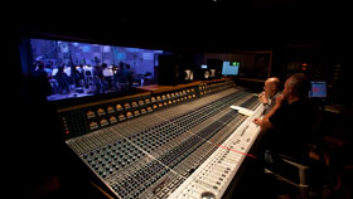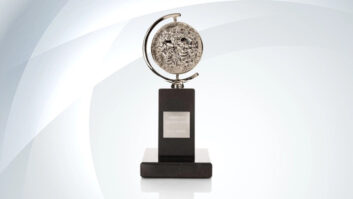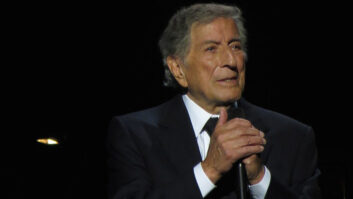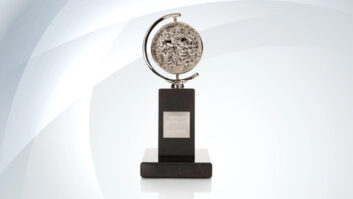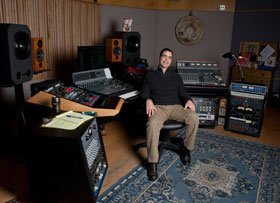
Tony Maserati in his mix room.
Photo: Ana Gibert
[Ed. Note: Mix magazine senior editor Blair Jackson continues his conversation with mix engineer Tony Maserati about working with Jason Mraz.]
You spent some time in the studio watching Jason record and talking to Joe [Chiccarelli].
That’s right, and that is partly the reason why it was a long, slow climb for me to get this record mixed. I’m not the kind of guy who sits down and does two mixes a day. I like to learn what the intentions were in the artist’s performance, as well as the producer. And speaking to the label—in this case Sam Riback, who is a great guy and very smart.
He’s quite involved, I gather.
Sam is very involved. He’s got that real classic touch of an A&R guy. He helps pick professionals he thinks will be appropriate and he lets them do their thing. He also offers great guidance and that’s not a common thing these days.
Does seeing the music performed give you a better understanding of the intention of the music and thus let you mix better?
Absolutely it does. The other thing I got out of visiting the studio was I could see Joe and Jason’s dynamic up close, and it was really great. They work fast and they both clicked together. But I could also see where they were leaving room for the next phase, which was me in this case. So Jason would ask me things about this song or that song., and when somebody does that at that level, it’s not some kid saying, “What do you think of my song?” I’ve got to think about as both a professional and an audience member, and in Jason’s case that’s really easy for me to do that because I’m actually a fan.
They probably had 25 songs and he played me a couple of songs that the fellas had gotten tired of maybe, or gone off of, or maybe they’d gone on too many fishing trips on the arrangement. Then they’d play me a version that was really early on and I be like, “Oh, my God, this is amazing! Why aren’t you paying attention to this?” “Oh, you know… blah, blah, blah.” So I’d be like a cheerleader and light a fire under some of the material, because it really was magical.
It’s pretty easy to overwork something in the studio.
I think that’s exactly what I noticed in some cases. I’ve got to give these guys a shot of 5-Hour Energy, give them some Jolt, because they had clearly been working on minute details for so long they’d lost some of the overall picture. I was able to stand back and say, “Wow, these are gems right here,” and see the record as a whole and see where they were going stylistically.

Jason Mraz listens to mixes in Tony Maserati’s mix room.
Photo: Ana Gibert
At that point, Jason went on the road with his background singer/percussionist, Toca [Rivera]. And they just played the material by themselves, just the two of them. They sat there and felt the crowd and they came back and they said, “We’ve got these three songs the crowd really loves.” I don’t know the exact story, but I think that’s how “I Won’t Give Up” came to the forefront. I think that’s a cool way for Jason to gauge where to go—what’s the best focus group in the world? An audience of your fans sitting there clapping.
Joe Chiccarelli said you deleted some horn parts at the mix stage.
I like to believe that what I’m here to do and the best way I can serve my client is to look at each song as an entity by itself. Will it stand by itself? Will it attract an audience? Will that audience be compelled to listen? Those are the things I’m thinking about at all times when I’m working. Quite often I’m given arrangements for the more poppy-type material I do that are very firm. They don’t really allow for any changes because the production staff is quite rigid about that form. But in the case of Jason, I know that to him it’s all a process and I know that he will listen, and he’s willing to change things.
One of the great things about the way I’m set up here [in my studio] is it takes me ten minutes to recall a song. I’ve got this great system called Tea Boy.
Did you say “Tea Boy”? Like what they call assistant engineers in England?
Right! [Laughs] Oh, my god, it saves my life. Colin Miller, out of Santa Cruz, was an assistant engineer to a friend of mine and he came up with this thing called Tea Boy, in which is he takes pictures of every piece of equipment without the knobs and then takes a picture of the knob itself, and then he’s created this program that can recall every piece of equipment with such accuracy that we rarely have any problems with recalls. The detail of the photographs is amazing, and it’s all saved up on a cloud; there’s no paper.
Wasn’t that the old Brian Eno technique—taking photos of the console so he could match the setting later?
No, it’s not that all. This isn’t my assistant standing over a piece of equipment. All the equipment is scanned in this program—every piece of equipment you can imagine. You go in and search for your piece of equipment and it comes up in huge, great detail. He has every variety of GML 8200 in there, so if the silk screening is slightly different from one model to the next, he’s got it. It’s amazing. It’s a visual representation of where the equipment was when you did your mix. I can have two guys in the room with laptops, and if I used 15 pieces of equipment, it’s done in ten minutes. We double-click, we open up, boom!
My point being, I know I can make a left turn and Jason can come back in and say, “No way, I love those horns, put them back in,” and it’s not going to take me but five minutes to get back to where I was, even if I’m a month down the road.
I tell my clients ahead of time, You push me back where you want me to go back. In the case of the horns, the original arrangement had a big, long horn bit to it. They were in the intro, in between verses; it was a big horn arrangement. And there was nothing wrong with the horn arrangement, save for the fact that I didn’t feel it supported the lyric and the sentiment of the song. I’m sure, at the time, Jason and Joe felt that did.
In my case, I’m always focusing on what’s going to serve this song. I’m not thinking about egos. If Joe called me up and said, “Those horns have to be in,” those horns are going to be in there, damn straight! But he didn’t. He said, “I like the horns,” and he continues to say, “I miss the horns,” and in no way do I discount his expertise; absolutely not. I just couldn’t figure out for myself how to get them in there without them being distracting to the sentiment. I’m sure if Chris Lord-Alge or Joe himself had sat down to mix the song, the might have figured out a perfect way to set them in there so they accomplished the goal of supporting the sentiment.
Jason had to approve it.
Yes, but he’s seeing it through my mix. Had Joe mixed it, he might have seen it through that lens and said, “Wow, that’s perfect.” It doesn’t negate anybody’s opinion or feeling about it. It’s just in my approach I couldn’t figure out how to make them support the sentiment.

